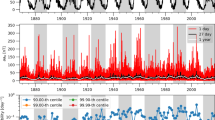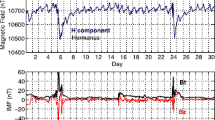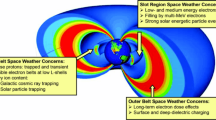Abstract
An attempt was made to determine on a global scale the zone of enhanced electron temperature (Te) in the subauroral ionosphere during magnetic storms via the combination of Te measurement data and images of stable auroral red arcs (red arcs) obtained on satellites. Data from Te measurements on the DMSP and CHAMP satellites and red-arc observation by POLAR spacecraft were used. It is shown that the zone of enhanced Te in coordinates of geographic latitude and local time can be determined during the period of red-arc manifestation based on the results of Te measurements for a relatively short time during the recovery phase of a geomagnetic storm, and the dependence of its parameters on universal time (UT control) can be found.








Similar content being viewed by others
REFERENCES
Craven, J.D., Frank, L.A., and Ackerson, K.L., Global observations of a SAR arc, Geophys. Res. Lett., 1982, vol. 9, pp. 961–964.
Frank, L.A., Sigwarth, J.B., Craven, J.D., Cravens, J.P., Dolan, J.S., Dvorsky, M.R., Hardebeck, P.K., Harvey, J.D., and Müller, D., The Visible Imaging System (VIS) for the polar spacecraft, Space Sci. Rev., 1995, pp. 297–328.
Golikov, I.A., Gololobov, A.Yu., and Popov, V.I., Mode-ling the electron temperature distribution in the F2 region of high-latitude ionosphere for winter solstice conditions, Sol.-Terr. Phys., 2016, vol. 2, no. 4, pp. 54–62. https://doi.org/10.12737/19424
Golikov, I.A., Gololobov, A.Yu., Popov, V.I., and Varlamov, I.I., Formation of a ring-shaped region of increased electron temperature in the subauroral ionosphere in winter, Geomagn. Aeron. (Engl. Transl.), 2019, vol. 59, no. 2, pp. 199–204. https://doi.org/10.1134/S0016793219020087
Golikov, I.A., Gololobov, A.Yu., and Baishev, D.G., Universal time control of the parameters of the electron temperature enhancement zone in the winter subauroral ionosphere, J. Atmos. Solar-Terr. Phys., 2020, vol. 211, p. 105458. https://doi.org/10.1016/j.jastp.2020.105458
Greenspan, M.E., Anderson, P.B., and Pelegatti, J.M., Characteristics of the thermal plasma monitors (SSIES) for the Defense Meteorological Satellite Program (DMSP) spacecraft S8 through S10, Tech. Rep. AFGL-TR-86-0227, Air Force Geophys. Lab. Hanscom AFB, Mass., 1986.
Ievenko, I.B. and Alekseev, V.N., Effect of the substorm and storm on the SAR arc dynamics: a statistical analysis, Geomagn. Aeron. (Engl. Transl.), 2004, vol. 44, no. 5, pp. 592–603.
Khalipov, V.L., Kotova, G.A., Stepanov, A.E., Ievenko, I.B., and Panchenko, V.A., Formation of red arc in the polarization jet band, J. Atmos. Sol.-Terr. Phys., 2018, vol. 179. https://doi.org/10.1016/j.jastp.2018.08.005
Kotova, G.A., The Earth’s plasmasphere: State of studies (a review), Geomagn. Aeron. (Engl. Transl.), 2007, vol. 47, no. 4, pp. 409–422.
Kovalevskii, I.V., Cold geomagnetospheric plasma heating processes, Geomagn. Aeron., 1982, vol. 22, no. 3, pp. 445–459.
Kozyra, J.U., Nagy, A.F., and Slater, D.W., High-altitude energy source(s) for stable auroral red arc, Rev. Geophys., 1997, vol. 35, no. 2, pp. 155–190. https://doi.org/10.1029/96RG03194
Maier, E.H., Chandra, S., Brace, L., Hoffman, J.H., Shepherd, G.G., and Whitteker, J.H., The SAR arc event observed during the December 1971 magnetic storm, J. Geophys. Res., 1975, vol. 80, no. 34, pp. 4591–4597. https://doi.org/10.1029/JA080i034p04591
Oyama, S., Shinbori, A., Ogawa, Y., et al., An ephemeral red arc appeared at 68° MLat at a pseudo breakup during geomagnetically quiet conditions, J. Geophys. Res., 2020, vol. 125, no. 10, p. e2020JA028468. https://doi.org/10.1029/2020JA028468
Reigber, C., Lühr, H., and Schwintzer, P., CHAMP mission status, Adv. Space Res., 2002, vol. 30, pp. 129–134.
Rich, F.J. and Hairston, M., Large-scale convection patterns observed by DMSP, J. Geophys. Res., 1994, vol. 99, no. A3, pp. 3827–3844. https://doi.org/10.1029/93JA03296
Shiokawa, K., Hosokawa, K., Sakaguchi, L., Leda, A., Otsuka, Y., Ogawa, T., and Connors, M., The optical mesosphere thermosphere imagers (OMTIs) for network measurements of aurora and airglow, feature perspectives of space plasma and particle instrumentation and international collaborations. AIP Conf. Proc., 2009, vol. 1144, pp. 212–215. https://doi.org/10.1063/1.3169292
Taylor, H.A., Jr. and Walsh, W.J., The light-ion trough, the main trough and the plasmapause, J. Geophys. Res., 1972, vol. 77, no. 34, pp. 6716–6732. https://doi.org/10.1029/JA077i034p06716
ACKNOWLEDGMENTS
The geomagnetic index data were obtained from the World Data Center C2 for Geomagnetism, Kyoto (http://wdc.kugi.kyoto-u.ac.jp/dst_realtime/index.html) and the World Data System of the International Science Council (http://www.wdcb.ru/stp/geomag/geomagn_Kp_ ap_Ap_ind.ru.html). Experimental data from the DMSP and CHAMP satellites were obtained from the CEDAR Madrigal Database (http://cedar.haystack.mit.edu/) and GeoForschungZentrum (GFZ) Helmholtz Center Potsdam (ftp://anonymous@isdcftp.gfz-potsdam.de/champ/ ME/Level2/PLPT/). Images from the photometer onboard the POLAR satellite and the all-sky camera at Millstone Hill station were obtained from the Coordinated Data Analysis Web (CDAWeb) (https://cdaweb.sci.gsfc.nasa.gov) and the Boston University Imaging Science Laboratory (http://sirius.bu.edu).
Funding
The work was carried out within the framework of a state assignment (state registration number no. АААА-А21-121012000007-4) and was partially funded by the Russian Foundation for Basic Research (project no. 18-45-140037 r_a).
Author information
Authors and Affiliations
Corresponding authors
Rights and permissions
About this article
Cite this article
Golikov, I.A., Gololobov, A.Y., Baishev, D.G. et al. Determination of the Enhancement in Electron Temperature in the Subauroral Ionosphere during Magnetic Storms on a Global Scale. Geomagn. Aeron. 61 (Suppl 1), S103–S115 (2021). https://doi.org/10.1134/S001679322201008X
Received:
Revised:
Accepted:
Published:
Issue Date:
DOI: https://doi.org/10.1134/S001679322201008X




